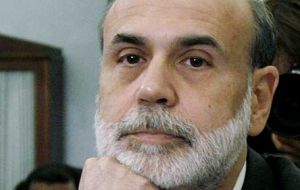MercoPress. South Atlantic News Agency
US Treasury bonds fetch negative yield ahead of Fed’s actions to prop inflation
 Fed Chairman Ben Bernanke wants inflation to rise to a 2% floor
Fed Chairman Ben Bernanke wants inflation to rise to a 2% floor US Treasury Department sold securities that fetched a negative yield for the first time, implying investors are willing to pay the government to own its debt. This is a milestone in the current rock-bottom interest rate environment, as the Federal Reserve is widely expected next week to announce it will buy more Treasuries to jump-start a sluggish economy.
Typically, investors buy a new Treasury bond at “par” or $100. At Monday's $10 billion auction of five-year Treasury Inflation-Protected Securities (TIPS), they paid more than $105 and accepted a bond that yields nothing even after factoring in a 0.50% semi-annual interest payment.
“This shows negative yields are not a turn-off to investors,” said Michael Pond, co-head of US rates strategy with Barclays Capital in New York. But some analysts cautioned negative yields, if they persist, could hurt TIPS demand.
“If issuing TIPS in a negative real rate environment requires zero coupons and up-front premium, we can see that becoming an issue,” said George Goncalves, head of US rates strategies at Nomura Securities International in New York.
While a negative yield clearly benefits the federal government by lowering its borrowing cost, investors bought the five-year TIPS, which was originally issued in April, on expectations that the Fed will succeed with another round of policy accommodation, dubbed 'QE2,“ analysts said.
If QE2 can raise inflation toward to 2%, a level which Fed Chairman Ben Bernanke recently cited, investors will profit from a widening in the yield gaps between TIPS and regular Treasuries. This could happen even if the real yields on TIPS remain negative, analysts said.
The five-year TIPS ”breakevens” was last quoted at 1.68 percent on Monday, compared with 1.25 percent in late August.
The US Treasury will sell 35 billion in two-year notes on Tuesday, part of this week's 109 billion coupon-bearing supply.
The Treasury has been borrowing cheaply since the Fed brought short-term rates down near zero since December 2008. It has sold bills at zero percent during episodes of safe-haven stampedes during the global credit crisis.
In the open market, five-year and other short-dated TIPS turned negative in late September on bets that increased bond purchases from the Fed will push down real interest rates, or borrowing costs excluding inflation.
Fed policy-makers have expressed worries over the threat of deflation, where a crippling cycle of falling prices and real interest rates could inflict long-term damage to an economy like Japan in the 1990s.
If it engages in further quantitative easing in the form of buying more bonds, the Fed hopes to wipe out deflation risk and inflate higher asset prices. Rising asset values could in theory encourage investments and spending and in turn bolster economic activity to more desirable level.




Top Comments
Disclaimer & comment rulesCommenting for this story is now closed.
If you have a Facebook account, become a fan and comment on our Facebook Page!